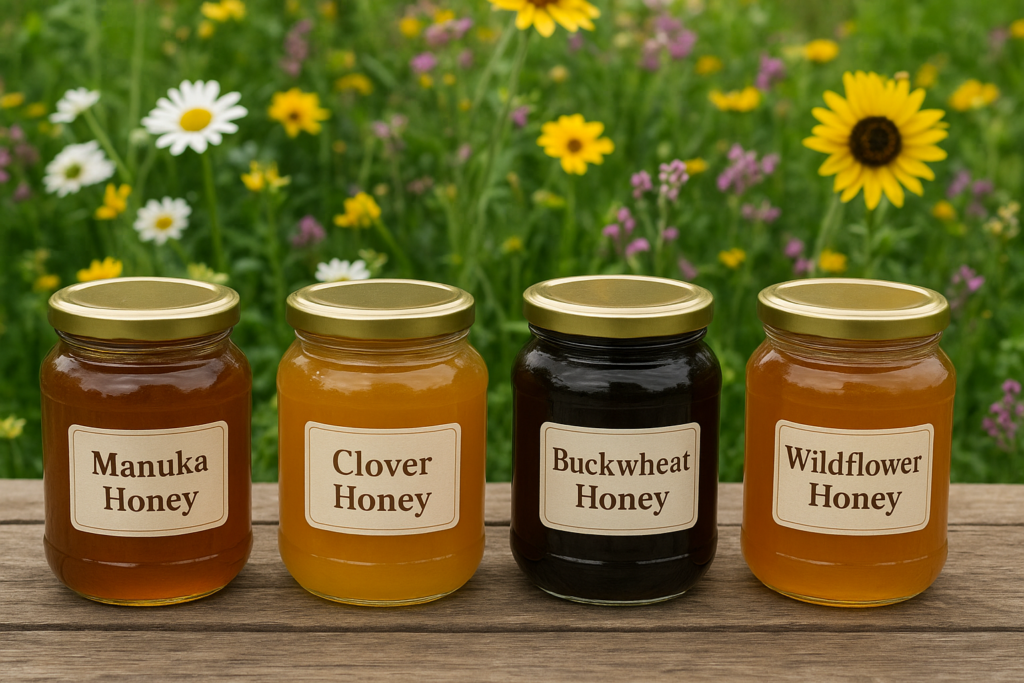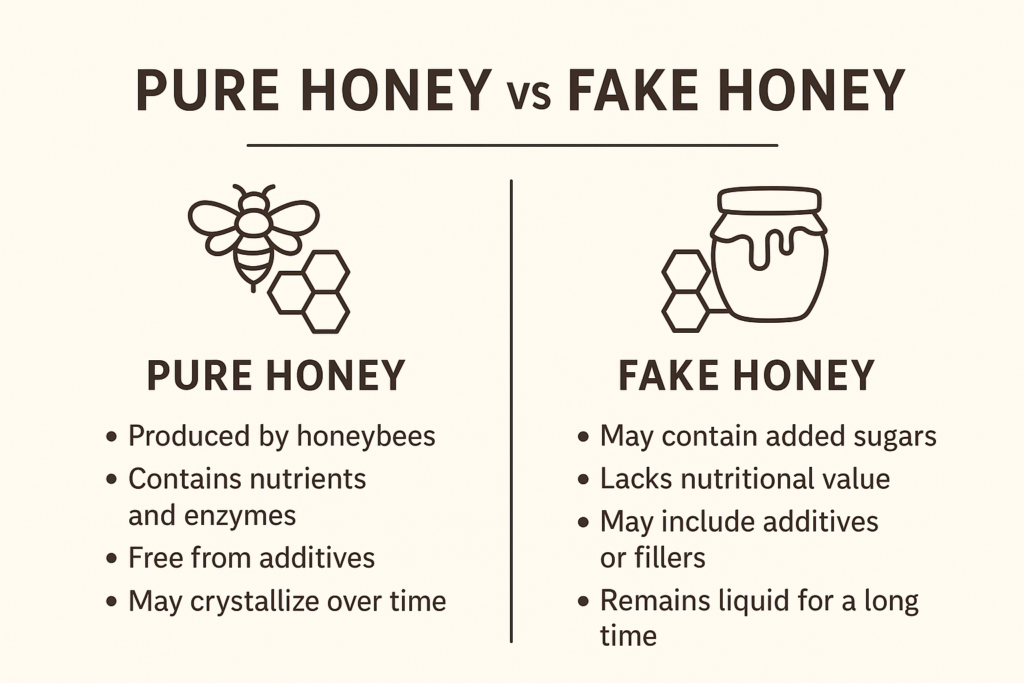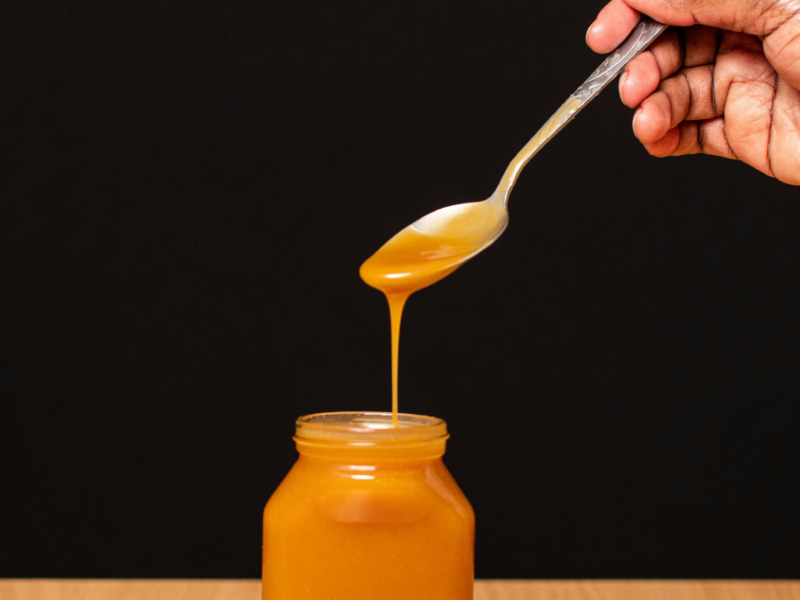Introduction
Honey has been celebrated for thousands of years, not only as a natural sweetener but also as a healing food with medicinal properties. From the ancient Egyptians using it for wound healing to modern health enthusiasts adding it to teas and smoothies, honey remains one of nature’s most versatile gifts.
But not all honey is the same. Depending on the floral source, region, and method of production, honey comes in a variety of colors, textures, and flavors—each with distinct health benefits. For consumers and beekeepers alike, understanding honey types, flavor notes, and purity is essential to appreciating its full value.
This comprehensive guide explores different types of honey, their flavor profiles, nutritional benefits, and how to spot pure honey versus adulterated varieties.
Types of Honey and Their Flavor Profiles
Honey varieties are primarily classified by their floral source. Here are some of the most popular types:
1. Clover Honey
- Flavor Profile: Mild, floral, sweet, with a clean aftertaste.
- Color: Light golden to amber.
- Notes: Clover honey is the most widely produced honey in North America. Its delicate sweetness makes it ideal for everyday use—sweetening tea, baking, or drizzling over toast.
2. Acacia Honey
- Flavor Profile: Very mild, with a hint of vanilla and a smooth finish.
- Color: Pale, almost transparent.
- Notes: Acacia honey crystallizes very slowly, making it popular for gourmet use. It’s especially favored by people who prefer a lighter flavor.
3. Manuka Honey
- Flavor Profile: Earthy, slightly bitter, rich, with medicinal notes.
- Color: Dark brown to amber.
- Notes: Produced in New Zealand from the nectar of the Manuka bush, this honey is world-renowned for its antibacterial and healing properties.
4. Buckwheat Honey
- Flavor Profile: Strong, malty, molasses-like, with a bold aftertaste.
- Color: Very dark amber, nearly black.
- Notes: Packed with antioxidants, buckwheat honey is often compared to blackstrap molasses. It’s a favorite in traditional remedies.
5. Wildflower Honey
- Flavor Profile: Varies greatly depending on the flowers in bloom; typically floral, complex, and slightly fruity.
- Color: Light to dark amber.
- Notes: Wildflower honey is unique to each region and season. It’s often used by local beekeepers to showcase regional biodiversity.

6. Orange Blossom Honey
- Flavor Profile: Sweet, citrusy, with delicate floral notes.
- Color: Light amber.
- Notes: Produced from orange tree blossoms, this honey pairs perfectly with yogurt, tea, and desserts.
7. Eucalyptus Honey
- Flavor Profile: Herbal, slightly medicinal, with cooling undertones.
- Color: Medium amber.
- Notes: Traditionally used for respiratory health, this honey has a unique aroma that makes it stand out.
8. Sage Honey
- Flavor Profile: Mild, delicate, with subtle herbal notes.
- Color: Light golden.
- Notes: Sage honey crystallizes very slowly, making it a preferred choice for those who like smooth, liquid honey.
9. Heather Honey
- Flavor Profile: Strong, aromatic, slightly bitter, with a woody aftertaste.
- Color: Amber to dark amber.
- Notes: Known for its gelatinous texture, Heather honey is highly valued in Europe for its medicinal and gourmet qualities.
10. Lavender Honey
- Flavor Profile: Floral, sweet, with herbal undertones.
- Color: Golden to amber.
- Notes: Produced in Mediterranean regions, lavender honey is prized for its soothing aroma and gentle sweetness.
Nutritional and Health Benefits of Honey
Honey is more than just a sweetener—it’s a functional food packed with bioactive compounds.
Key Benefits:
- Rich in Antioxidants – Protects against free radicals.
- Natural Antibacterial Properties – Especially strong in Manuka.
- Boosts Immunity – Regular use may strengthen resistance to illness.
- Soothes Sore Throats & Coughs – Natural cough suppressant.
- Supports Digestive Health – Contains enzymes and probiotics.
- Natural Energy Booster – Quick source of glucose & fructose.
- Skin & Hair Benefits – Moisturizing, antibacterial, anti-acne.
1. Rich in Antioxidants
Different types of honey contain phenolic compounds and flavonoids that help neutralize free radicals in the body, reducing oxidative stress. Darker honeys, like buckwheat, generally have higher antioxidant levels.
2. Natural Antibacterial Properties
Manuka honey is particularly renowned for its antibacterial effects, but most raw honeys contain hydrogen peroxide, a natural antiseptic that aids in wound healing.
3. Boosts Immunity
Regular consumption of raw honey may strengthen the immune system, thanks to its antiviral, antifungal, and antibacterial properties.
4. Soothes Sore Throats and Coughs
Honey acts as a natural cough suppressant. A spoonful of honey can coat the throat, reduce irritation, and ease coughing—especially effective in children.
5. Promotes Digestive Health
Raw honey contains enzymes and probiotics that support gut health. It’s also used as a remedy for acid reflux and indigestion.
6. Natural Energy Booster
Honey is a quick source of glucose and fructose, providing an instant energy boost, which makes it ideal for athletes and active individuals.
7. Skin and Hair Benefits
Honey is widely used in skincare and haircare products due to its moisturizing and antibacterial qualities. DIY face masks with honey can help fight acne and hydrate skin.

How to Identify Pure Honey
Unfortunately, honey is one of the most commonly adulterated foods. Cheap, artificial syrups are often mixed in to increase volume. Here’s how to check if your honey is pure:
✅ Label Check: Look for “raw,” “unfiltered,” “unpasteurized.”
✅ Water Test: Pure honey sinks, fake dissolves.
✅ Thumb Test: Pure honey sticks, fake runs.
✅ Crystallization: Natural honey crystallizes over time.
✅ Smell & Taste: Pure honey has a floral aroma, fake tastes artificial.
1. Read the Label Carefully
Look for terms like “raw,” “unfiltered,” “unpasteurized,” and avoid labels that list additives like corn syrup.
2. The Water Test
Drop a spoonful of honey into a glass of water. Pure honey will settle at the bottom, while adulterated honey dissolves quickly.
3. Thumb Test
Place a drop of honey on your thumb. Pure honey stays in place, while fake honey spreads or runs off easily.
4. Check for Crystallization
Pure raw honey often crystallizes over time. If your honey remains liquid for years, it may have been ultra-filtered or adulterated.
5. Smell and Taste
Pure honey has a distinct aroma and floral taste depending on its source, whereas fake honey often tastes overly sweet or artificial.
💡 Did You Know?
- Bees need to visit 2 million flowers to produce just 1 pound of honey.
- Honey never spoils—archaeologists found edible honey in Egyptian tombs.
- Darker honeys often contain higher antioxidant levels.
- A honeybee produces only about 1/12th of a teaspoon of honey in her lifetime.
Best Ways to Enjoy Honey
- Stirred into tea or coffee
- Drizzled over yogurt, pancakes, or oatmeal
- Used as a natural sweetener in baking
- Mixed with warm water and lemon for detox drinks
- Applied as a natural face mask or skin treatment
❓ FAQ – Common Questions About Honey
Q1: Is raw honey safe for children?
A: Children under 1 year should never consume honey due to the risk of infant botulism.
Q2: Does honey expire?
A: No, honey has an indefinite shelf life if stored properly.
Q3: Which honey is best for health?
A: Manuka is best known for medicinal use, but darker honeys like buckwheat have high antioxidants.
Q4: Can diabetics consume honey?
A: In moderation—honey still raises blood sugar, but has more nutrients than refined sugar.
Conclusion
Honey is not just a sweetener—it’s nature’s golden medicine. From clover to manuka, each type of honey has its own flavor profile and health benefits. Understanding the differences allows you to make informed choices about which honey to buy and how to use it.
Most importantly, always seek out pure, raw honey from trusted sources to ensure you’re getting the maximum health benefits.
Whether you’re a beekeeper, health enthusiast, or simply someone who loves the taste of honey, exploring its many varieties opens up a world of flavor and wellness.



